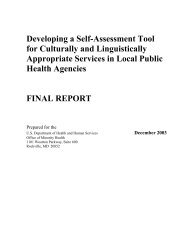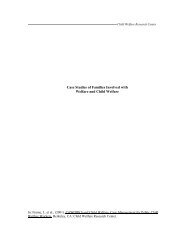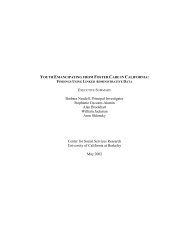Family Assessment in Child Welfare - Center for Social Services ...
Family Assessment in Child Welfare - Center for Social Services ...
Family Assessment in Child Welfare - Center for Social Services ...
Create successful ePaper yourself
Turn your PDF publications into a flip-book with our unique Google optimized e-Paper software.
descriptive and discrim<strong>in</strong>ative power <strong>in</strong> comparison to the other two Beavers measures (Drumm,Carr, & Fitzgerald, 2000). Although some studies have adm<strong>in</strong>istered and evaluated these<strong>in</strong>struments separately, the developers of the Beavers model <strong>in</strong>dicate that a more comprehensivefamily assessment would be facilitated by the conjunctive use of all three <strong>in</strong>struments (Beavers& Hampson, 2000).Background CharacteristicsThree measures were identified as possible candidates <strong>for</strong> the assessment of familybackground characteristics related to a history of child abuse and neglect; namely, the <strong>Family</strong>Systems Stressors Strength Inventory (FSSSI), the Hispanic Stress Inventory (HIS), and theOntario <strong>Child</strong> Neglect Index (CNI). While these measures have been designed <strong>for</strong> cl<strong>in</strong>ical use,more psychometric evaluation is needed to determ<strong>in</strong>e their validity and reliability.<strong>Family</strong> Systems Stressors Strength Inventory. The FSSSI is a 53-item self adm<strong>in</strong>isteredquestionnaire that is designed to identify the perceptions of family members regard<strong>in</strong>g generaland specific family stressors and strengths. When used as a cl<strong>in</strong>ical tool, the <strong>in</strong>strument canprovide direction <strong>for</strong> <strong>in</strong>tervention plann<strong>in</strong>g and has the advantage of assess<strong>in</strong>g family strengthsas well as difficulties. Content validity was assessed through <strong>in</strong>ter-rater agreement <strong>for</strong> conceptualfit and <strong>for</strong> clarity of items. However, as previously mentioned, very little psychometric data areavailable <strong>for</strong> this <strong>in</strong>strument and reliability of this <strong>in</strong>strument is unknown (Touliatos et al., 2001).Hispanic Stress Inventory. The HIS is designed as a culturally appropriate tool <strong>for</strong>assess<strong>in</strong>g stressors with<strong>in</strong> Hispanic families, <strong>in</strong>clud<strong>in</strong>g marital stress, family stress, occupationalstress, economic stress, discrim<strong>in</strong>ation stress, and acculturation stress. Two versions of the<strong>in</strong>strument are available, a 73-item self-report questionnaire designed <strong>for</strong> use with immigrantfamilies and a 59-item self-report questionnaire adapted <strong>for</strong> US-born family members. A keyadvantage of the HIS is its culture-specific application <strong>for</strong> diagnos<strong>in</strong>g and plann<strong>in</strong>g <strong>in</strong>terventions<strong>for</strong> Hispanic families, and its subscales have been found to have high <strong>in</strong>ternal consistency andhigh test-retest reliabilities (Cervantes, Padilla, & De Snyder, 1991). Additional psychometrictests should be conducted <strong>in</strong> order to further substantiate its reliability and validity (Touliatos etal., 2001).Ontario <strong>Child</strong> Neglect Index (CNI). The Ontario CNI is a brief 6-item caseworker-rated<strong>in</strong>strument, which is designed to identify the type and severity of neglect that children experiencefrom their primary caretakers. In addition to evaluat<strong>in</strong>g history of physical abuse, sexual harm21
















